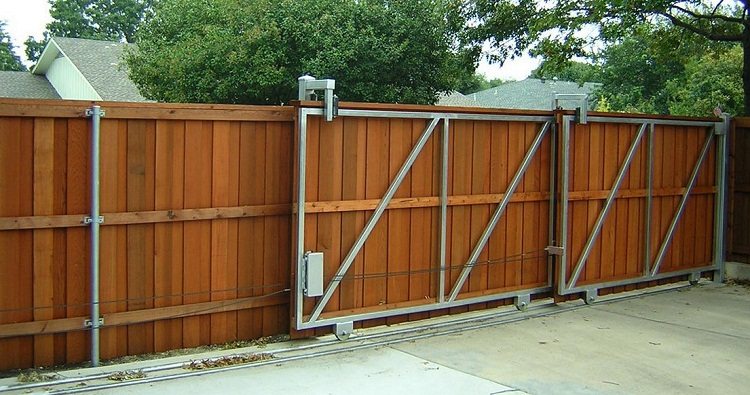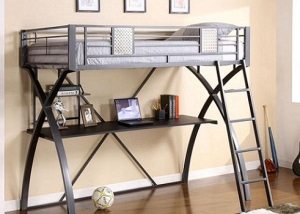The durability of the fence on the site depends on whether the material was correctly selected for its supporting structure. Metal pipes have a large number of advantages compared to other types of supports: concrete or even more so wooden. On metal supports, details of the intake web or individual sections are easily installed. Due to their considerable weight, metal pipes will support the weight of the entire fence even in the most severe weather conditions.

Strength and durability of metal pipes make it possible to use them as the basis for fences of any purpose
Content
What are metal pipes for the fence?
Do not confuse the intake pipes with other types of metal, designed for water or gas. The intake pipe (or support) is made of high strength material, most often steel. The diameter of the product and the thickness of its walls is determined by the relevant GOST or TU of the manufacturer.
Intake pipes include profile metal products of square or rectangular cross-section, but round poles can sometimes be used. This option is possible if you plan to install a mesh fence. In this case, fastening is carried out using metal hooks, which will be welded to the support posts. Round pipes are used when it is necessary to reduce the time for installation work. They do not require laying the foundation, for the stability of the fence it is enough to immerse the supports in the ground by driving them with a hammer or screwing them in.
Important! If round intake pipes without a foundation are used, then the supports will have to be deepened by at least 80-90 cm in dense soil, and in soft - at least 1.2 m.
For fences with a more severe load, only profile structures are used. They are distinguished by the presence of stiffeners, which positively affects the level of reliability. Also, profile pipes are easier to install than round.
The following factors will be the advantages of metal intake pipes:
- such products can withstand the loads of even bulky fences;
- steel pipes are problem-free paintable. The paint performs not only an aesthetic function, but also helps protect the metal from premature corrosion;
- the possibility of use in the design of fences with an exclusively decorative purpose;
- metal fence supports can be used repeatedly. If you want to reduce the cost of installing the fence, you can even purchase a used rental.
Types of fences from metal pipes
Pillars made of metal can be used in such types of fences:
1. Decking. Economical, lightweight and durable material. It is used both independently and in a combined form.
2. Wooden fences. Wood is an environmentally friendly and inexpensive material; therefore, it continues to be popular, despite its low operational life.
3. The grid "netting". It is made of polymeric materials or metal. Plastic chain links are installed on temporary fences, as the polymer does not provide high strength.Rarely used to fence the site without the use of an additional fence, as they create a complete overview of the territory.

Any type of material can be installed on the base of the pipes, the fence can be made deaf or trellised
4. Forged fences. As a rule, they are installed as decorative fences. As in the previous case, forged elements retain the visibility. In terms of reliability, it surpasses metal grids, but has a much higher price. For this reason, forged fences are often combined with other types of fences, for example, with brick sections or pillars.
How to choose the intake pipes?
When choosing supports for an intake structure, attention should be paid to the technical characteristics of the metal pipe. The main parameters are:
1. The diameter of the cross section. The larger the diameter of the profile pipe, the more stable the support structure. Poles with insufficient diameter can cause the fence to fall due to strong winds. If the fence has a height in the range of 1.8-2.0 meters, then a square pipe with a size of 80x80 will be the best choice. For a mesh fence mounted on round supports, there will be enough pipes with a cross section of 60 mm. The minimum pipe wall thickness is 3 mm.
Forged metal fences require intake pipes with a cross section of at least 50 mm. If a low fence is installed, then pipes with a cross section from 40 mm to 60 mm are allowed. The wall thickness can be reduced to 2 mm.
2. Type of steel. Galvanized steel pipes demonstrate the best indicators of wear resistance, but their installation as fence supports is a rather expensive undertaking. The most commonly used pipes are black steel without spraying, which require more careful care. It is necessary to renew the paint layer on such structures annually; if rust appears at their base, it should be cleaned.
3. The height of the posts. The length of the supports depends on the size of the sections of the fence, the composition of the soil and the specific gravity of the fence. If the soil on the site is loose and loose, then the length of the supports will have to be increased by 10-15 cm, taking into account the depth of the soil. The level of sailing also depends on the height of the pillars - the ability of the support pillars to maintain the fence in its original position in a hurricane wind.
How to calculate the number of posts?
To determine the amount of materials needed, you need to use a simple formula: divide the perimeter of the plot by the distance between the supports. The optimal length of the distance between the fence posts depends on the type of cross-section of the pipes used:
- for round pipes - from 2 to 2.5 m;
- for profile pipes - from 2 to 3 m.
The type of fence also affects the choice of distance between supports. The heavier and more massive the fence, the smaller the distance should be observed between the posts. For fences made of light materials, corrugated board or mesh, the distance can be increased up to 3 m, with the condition of a pipe length of up to 6 m. Forged fences, the weight of which significantly exceeds the weight of corrugated boards, require a more frequent arrangement of supports.
Do not increase the distance between sections only on the basis of cost and time savings. The distance between the spans and the number of columns should be such that the joining of horizontal runs is clear, and the stability of the entire structure is not in doubt. If the owner of the site cannot determine the type of soil or other important criteria independently, it would be advisable to seek the advice of a specialist.
Installation of metal pipes for the fence
The installation of metal poles has a lot in common with the installation of any other supporting bases.All the work of digging the foundations into the ground and preparing for the installation of the fence sections can be done, if not independently, then with the help of another person. The installation process of the supports is divided into the following steps:
1. The markup. It is most convenient to make markings using wooden pegs. They are driven in at the corners of the planned fence, pulling a thread between them. The next step is to start only after the markup has taken the correct geometric shape.
2. In accordance with the results of calculations on the number of support columns, pegs are also installed in the places of their digging.
3. In the areas marked with pegs, indentations for metal posts are dug. You can dig out the soil with an ordinary shovel, but much faster this process occurs using a manual drill.
4. The column is installed in the recess. If the installation method without a foundation was chosen, then the lower part of the support is simply buried and tamped with earth. In other cases, when the cement slurry is the fastening component, a layer of sand is poured into the recess. Then water is poured out, a layer of sand is rammed.
Helpful advice! If the soil is too loose in the area, then a layer of sand is poured into the depression even before the metal column was installed in the cavity of the pit.
5. The evenness of the installation of each column is checked from all sides by the building level. In order to prevent the pillar from tilting during the period of cement hardening, the pipe is propped up with wooden beams on both sides.
6. A cord is pulled over the top of the support pillars, which should be installed first. This is necessary in order to simplify the process of aligning the intermediate posts in height. If any of the pits turn out to be deeper, the right amount of sand is added to them.
7. After it was succeeded to be convinced of identity of height of each column, each hole is filled with crushed stone. This allows you to more firmly hold the supporting pillars, especially in the case of clay soil.
8. Crushed stone is compacted, covered with coarse sand. The sand is poured again and rammed. Only after this can we begin concreting the recess. For lightweight fences, the amount of crushed stone can be reduced, for heavier gravels more will be needed.
Horizontal logs are allowed to be installed after the concrete mortar is completely solidified, after 2-3 days. The lag is fastened by welding. It is also possible to install lags mechanically, but it will take more time. Upon completion of the process of welding and cooling of parts, they start painting the fence. Before painting on the steel surface, a layer of anti-corrosion primer can be applied.
Also, in order to reduce corrosion processes, pipes for a metal fence should be worn. In addition to protecting the support column from penetration into the sediment and stagnation in the pipe cavity, this element also performs a decorative function.
After these actions, the frame will be completely ready for further installation of intake elements and sections. Setting the basis for the fence is an event that is quite feasible to carry out independently, without the help of a team of specialists.









